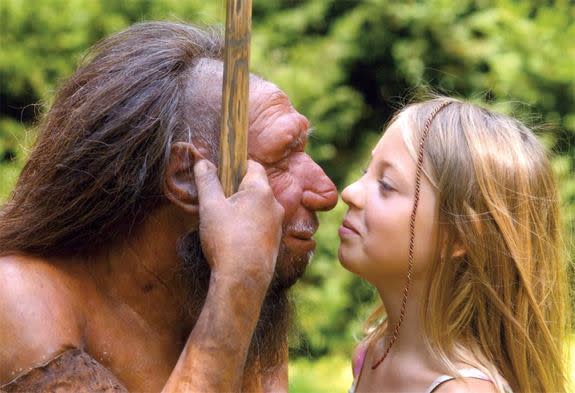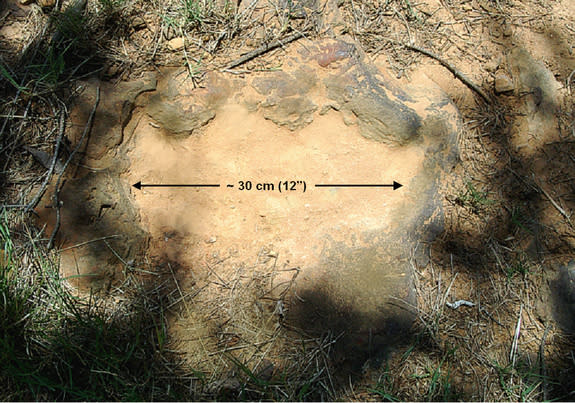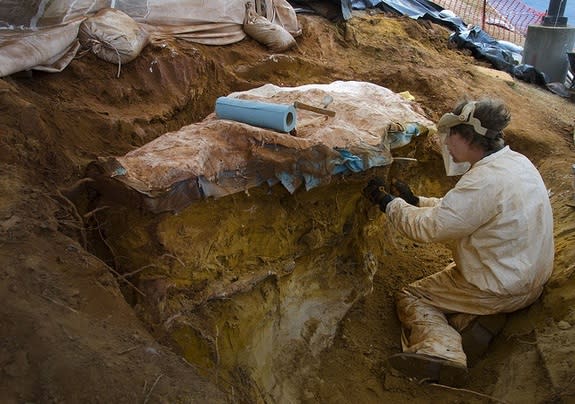© Stephanie Rausser
Way to Blow It #1: Tell a Big Ole Lie"My two-year-old daughter, Chloe, fights me about going to her babysitter's house every Monday," says New Jersey mom Gina Kane. One morning when Chloe refused to get out of the car, "I pointed to the house next door and told her it was a daycare center run by the caveman from the Geico commercials, which really scare her," says Kane. "I said she had a choice: Go to the sitter's house or to the caveman's daycare." Mission accomplished -- Chloe dashed to the sitter's door. Fast-forward a week: The babysitter casually asked Kane if she knew of a daycare center in the neighborhood because her daughter couldn't stop talking about it. "I was mortified having to explain, and Chloe now thinks that all daycare centers are run by cavemen," Kane admits. "I'm in big trouble if I ever actually have to send her to daycare."
A Better Way: Little white lies are so tempting in a pinch. You might even get away with them sometimes. Another mom had a great run while her toddler was afraid of a local clown named Macaroni. Whenever he refused to cooperate, she'd just say, "Maybe we should get Macaroni!" and the little guy would immediately don his pj's or gobble his carrots. But as Kane found out, scare tactics can and do come back to bite you in the butt, so it's best to be honest, says Bonnie Maslin, author of Picking Your Battles. Kane could have said instead, "I know sometimes you don't want to go to your babysitter. Sometimes I don't want to go to work." Empathizing would have made the Monday-morning transition easier.
Way to Blow It #2: Back Down You want a surefire way to make sure your kids never listen to you? Threaten but don't act. My daughter Ella and I recently went for a playdate at a friend's house, where the little girl kept snatching away whatever toy Ella picked up. Her mom would say, "Give that back to Ella or I'll take it away," and then turn back to our conversation. Of course, as soon as Ella moved on to another toy, the little girl wanted that one.
A Better Way: It's no fun to be the bad guy, but if a child acts out, there has to be a consequence. "Repeatedly saying 'If you don't stop throwing sand, I'm going to make you leave the sandbox' won't stop the bad behavior," says Bridget Barnes, coauthor of Common Sense Parenting for Toddlers and Preschoolers. "What your child hears is 'I can keep doing this a few more times before Mom makes me stop.'"
Instead, give a warning, and then, if your child does it again, give an immediate consequence such as a time-out. If he continues, leave. The next time, a gentle reminder should do the trick: "Remember how we had to leave when you threw the sand? I hope we don't have to go home early again today."
Way to Blow It #3: Dis Dad (or Vice Versa) When Polly Lugosi and her husband, Jim, take their two kids, Zoe, 5, and Miles, 2, out for a treat, this Milwaukie, OR, couple tells them that they have to behave or they won't get it. "Unfortunately, my husband is a complete pushover and always gives them the treat even if they act up," says Polly.
A Better Way: Even though Jim doesn't mean to undermine Polly's efforts, that's exactly what he's doing. Showing a united front won't just help your child behave better, it'll also prevent you from feeling like the bad guy all the time. "If you and your husband prefer to use different punishments, that's okay -- just as long as there are consequences for the same actions," says Nancy Schulman, coauthor of Practical Wisdom for Parents: Demystifying the Preschool Years. When your child is out of earshot, create a list of rules and discuss different options, she says.
Way to Blow It #4: Bribe a Little Too Often "My two-year-old daughter, Isabelle, has never been a great eater," says Liz Samuel, a mom in Montclair, NJ. "So I once offered her a piece of chocolate if she would just finish her lunch." The reward worked perfectly: Isabelle ate her chicken and sweet-potato fries -- but then she demanded another treat at dinnertime. "Now, whenever I want her to eat, she asks for either chocolate or a lollipop," complains the mom. "Plus, she'll eat just one fry and then expect her treat."
A Better Way: We all need to keep a good bribe up our sleeves -- to get through the grocery store, a church service, or that new episode of Mad Men you had to TiVo because you were too whipped to stay up for it. But the experts insist that reinforcing good behavior is a better way to go. "So instead of saying 'If you're good at Grandma's today, I'll buy you a toy,' try 'I'm really proud of you for sitting so nicely during dinner at Grandma's,'" advises Maslin. And don't underestimate the power of disappointment. "Saying 'I'm really sad you broke the present Daddy gave me' makes a child feel appropriately bad about his behavior," says Maslin. "You may feel like a terrible parent in the moment, but you're actually helping your child develop a conscience."
Way to Blow It #5: Break Your Own Rules When Anne Wear's 2-year-old son, Brandon, would do things he shouldn't -- take his mom's car keys or pull books off the shelf, for example -- this High Point, NC, mom would slap his hand and say "No, sir!" in a harsh tone of voice. "It worked great," she says, "until his preschool teacher caught him slapping the hands of any child who took his toy or cut in front of him in line!" Wear quickly realized that she couldn't say it was wrong for Brandon to smack his friends' hands when she and her husband, Brian, were doing the same thing to him. "We switched to time-outs," says Wear.
A Better Way: Not only are kids little mimics, emulating your bad behaviors, but they'll call you on it, as Suzi Dougherty found out. Her 2-year-old, Will, knows that throwing toys in the house is a definite no-no. "But one day my husband, Chris, threw a dog toy into the next room, just to get it out from underfoot," says this Newburgh, NY, mom. "Will immediately ordered him into a time-out! Since then, we try to be more careful and follow our own rules," she says. "But on the plus side, at least it showed us that the 'no throwing toys' rule is starting to sink in!"
Way to Blow It #6: Lose It Taking care of an active toddler requires a lot of patience. But there are times when Gabrielle Howe of Staten Island, NY, finds herself at the end of her rope when dealing with 2-year-old Thea. "One particularly trying day I completely lost it and yelled at Thea," admits this working mom. "She then tried to send me to my room!"
A Better Way: Time-outs aren't just for kids -- they work great for adults, too. "Give yourself permission to walk away," says Schulman. "Take a deep breath, count to ten, and then you'll be much more effective when disciplining your child." Walk into another room if you need to, as long as your child is safe in his crib or a childproofed room. "If you can't leave your child alone, then you should both go into another room," she adds. "Often a change of scenery will help you both cool off." If your husband or a friend is around, just say "I need a break, can you handle this one?" suggests Schulman. And remember that kids are expert at pushing your buttons, but if you can avoid letting the situation escalate by giving one warning and then an immediate consequence, it may help keep you both calm.
Way to Blow It #7: Wait Too Long Recently I was stuck in traffic with my 2-year-old daughter, Ella, when she started getting fidgety and tried to wiggle out of her car seat. Frustrated by both the slow trip home and the endless rounds of "Row, row, row your boat," I told her that if she didn't put her buckle back on correctly, she wouldn't get to have a bedtime story that night -- a technique that works great when my daughter's procrastinating about getting into her pajamas or brushing her teeth before bed. This time, though, bedtime was hours away -- and the threat pretty much meaningless. Ella didn't stop playing with her seat buckle, and it seemed pointless to remind her about it hours later when she was getting ready for bed.
A Better Way: "Kids don't remember what they did wrong an hour after the fact, never mind the next day," says Barnes. "You want to show them the consequences of their actions as close to the bad behavior as possible." If your child hits a friend with a toy truck, don't cancel tomorrow's playdate -- just take away the truck.
Way to Blow It #8: Talk On... and On... and On My husband, Patrick, tends to launch into long explanations with Ella, like how going to sleep is a good idea because she'll feel well rested for our upcoming busy day at Grandma's house. Tempting as it can be to try and reason with a young child, you might as well be speaking gibberish.
A Better Way: "Kids are not mini-adults," says Barnes. "Long explanations or instructions go right over their heads." Saying "No cookies before dinner" is enough to get the point across; you can skip the lecture about how sweets will spoil a tiny appetite. Keep your words age-appropriate, too. "I had one parent who was tired of always telling his son to stop whining," says Barnes. "Then one day his child finally asked, 'What's whining?'" It's okay to use a term like whining as long as you explain what you mean: "I can't understand you when you whine. Please use your big-boy voice."
Getting Back on Track You gave a warning, then caved in. Or you yelled at your kid- for yelling at you. Below, how to fix your own bad behavior, from Nancy Schulman, coauthor of Practical Wisdom for Parents.
Get Over It "We all make mistakes," says Schulman. "Don't beat yourself up. Just say 'I know I said -- or did -- something I shouldn't have. Let's try to all follow these rules from now on.'"
Take it Slow Even if you feel like your discipline techniques need to be completely overhauled, pick two of your top issues and start there. Don't overwhelm your child with 20 new rules. "Sit down when he's calm and go over the rules so he knows what's expected of him," says Schulman.
Work Around It Let's say your child always has a tantrum over what to eat for breakfast. Rather than duke it out each morning, offer your child just two choices -- say, cereal or eggs -- so he can still feel in control.
Give it Time "It takes time to undo a pattern of bad behavior," notes Schulman. "If you start being consistent, they'll catch on. It may take ten or twenty times, but they'll get it."
( Parenting.com )Blog :
Brilliant Purple |
8 Things You Should Never Say to Your Kid







